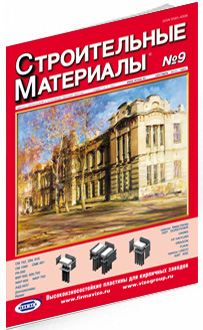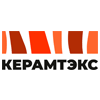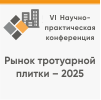Stroitel`nye Materialy №9

September, 2012
Table of contents
I.N. TIKHOMIROVA, Candidate of Technical Sciences, A.V. MAKAROV, engineer(rakhartr@bk.ru), the D. Mendeleyev University of Chemical Technology of Russia
The work is devoted to the use of mechanical activation of lime-quartz raw mixes for production of binders without autoclave hardening. The influence of mechanical activation on the composition and the anion structure of the amorphized zone on quartz particles under various conditions is considered. The possibility of generation of structures similar to irregular solid solutions of calcium in amorphous silica on the surface of quartz grains is shown; a quantitative assessment of mechanical-chemical reaction products is presented.
Keywords: quartz, lime, mechanical activation, lime-silica binder.
The work is devoted to the use of mechanical activation of lime-quartz raw mixes for production of binders without autoclave hardening. The influence of mechanical activation on the composition and the anion structure of the amorphized zone on quartz particles under various conditions is considered. The possibility of generation of structures similar to irregular solid solutions of calcium in amorphous silica on the surface of quartz grains is shown; a quantitative assessment of mechanical-chemical reaction products is presented.
Keywords: quartz, lime, mechanical activation, lime-silica binder.
V.V. NELYUBOVA, Candidate of Technical Sciences, I.V. ZHERNOVSKY, Candidate of Geological and Mineralogical Sciences, V.V. STROKOVA, Doctor of Technical Sciences, M.V. BEZRODNYKH, undergraduate, the Belgorod State Technological University named after V. G. Shukhov
Certain properties of silicate autoclave materials with the use of a nanostructured modifier after the effect of high temperature are presented. The formation of strength properties of silicate materials under the epicrystallization thermal effect is substantiated.
Keywords: silicate materials, temperature, nanostructured, strength
Keywords: silicate materials, temperature, nanostructured, strength
WKB Systems GmbH - the relationship between people and technology
WKB Systems GmbH Co. is an internationally recognized manufacturer of high-tech equipment for the building materials industry and forging industry as well as robotic automation of production processes. Basic principles of the company operation are described; main types of equipment manufactured for the silicate industry (hydraulic presses of WKP series, units for packing of rustication, splitting and rustication, hydrophobization et al.)
There is a description of two projects of Masa: expansion of a silicate brick factory in the Netherlands by commissioning of HDP 800 and HDP 1200 Jumbo presses and an automated line for wet cutting of figured silicate elements; construction of a silicate brick factory in the southwest of Byelorussia
I.A. GALEEV, General Director, OOO “INVEST-TECHNOLOGY” (Chelyabinsk)
The project of a silicate brick factory of 100 million pieces of conditional brick a year in Kaluga is described. Distinctive characteristics of the equipment used – VIKING presses, a hydraulic system, automatic stacker et al. – are given.
A. BABEL, Würschum GmbH Co. (Germany)
Advantages of using inorganic powdery pigments are presented. Possibilities of the dosing equipment for silicate mass coloration at the periodic technology when the pigment is injected portion by portion in a dry kind after the reactor. The technological scheme of injection of pigments in the silicate mass is described.
G.V. KUZNETSOVA, associate professor, V.G. KHOZIN, Doctor of Technical Sciences, the Kazan State University of Architecture and Civil Engineering
The history of introduction of the silicate brick coloration technology is presented. Recommendations for the quantitative introduction of pigments are made. It is shown that in the course of pigment introduction the activity of the mix decreases, the hardness of the mix increases.
Keywords: pigment, moulding mix, activity, binder, sample.
Keywords: pigment, moulding mix, activity, binder, sample.
V.Yu. OREKHOV, Commercial Director, “Roskhimprom” Co. (Rostov-on-Don)
A new product at the pigment market – Turkish ferrous oxide pigment Printonik ASY-1315 – is presented. Advantages of powdery pigments over the compacted and granulated ones are described. The influence of the intensity of products coloration depending on the increase of a share of a pigment, the color of the used sand, the pressure in the autoclave et al. is described.
V.V. KOBYLIN, General Director, OAO “PKB “Tekhnopribor” (Cheboksary)
The comparative analysis of types of mechanical conveyors and pneumatic transport the mostly used in industry of silicate materials is made. Peculiarities of various types of equipment are illustrated by an example of material feed of 50 tn/hr at the distance of 40 m. Orientation in the space – limitations on transport equipment arrangement, ecological compatibility, energy efficiency, reliability, simplicity of use and maintenance et al. are used as estimation criteria.
D.A. PONOMAREV, General Director, GBH "RUD Russland Conveyors & Systems" (Moscow)
Main systems of round steel chains, “a central chain”, are presented. Methods of mounting of chain elevator cups and also their modernization are illustrated. Systems of “dust-free in-plant transport” are described.
Modern conditions of the silicate industry are reflected; main types of silicate products manufactured are presented. The activity of NP “APSI” aimed at the actualization of SNiP II-22-11, gost 379-95 “Silicate brick and stones. Technical Requirement” and STO “Masonry made of silicate products (brick, stones, blocks). Rules of works execution and control over their performing
E.V. FOMINA, Candidate of Technical Sciences, I.V. ZHERNOVSKY, Candidate of Geological and Mineralogical Sciences, V.V. STROKOVA, Doctor of Technical Sciences, the Belgorod State Technological University named after V. G. Shukhov
It is established that the replacement of a part of the quartz component by alumina-silicate rocks of volcanic origin (pearlite) at the manufacture of autoclave gas concrete leads to substantial changes in the phase composition of hydrated new formations, which positively affects the strength properties of the material.
Keywords: gas concrete, alumina-silicate raw materials, calcium hydrosilicate.
Keywords: gas concrete, alumina-silicate raw materials, calcium hydrosilicate.
S.B. PROKHOROV, Director, OOO “NSK-TEK” (Ekaterinburg)
Market of Gasifiers in Russia. Criteria of Assessment and Tendencies of Development
Prognoses of the development of gas concrete production are presented. The transition of gas concrete production to the use of specialized gasifiers is substantiated. Advantages of gasifiers with unbound structure under the pretext of “Gazobeto+” (STO 75754739-001–2010) are shown.
, General Director, OOO “Renovatsiya” (Moscow)
Distinctive features of bearings with an antifriction filler and areas of their application are resulted. Design features and properties of the bearing AFZ are described. Possibilities of the use of bearings in various industries are shown.
A.A. SEMENOV, Candidate of Technical Sciences, General Director, OOO “GS-Expert”
The analysis of the market of mobile and movable crushing and sorting plants in 2006-2011 is presented. The export and import ratio is considered; the structure of supply by the firm-manufacturers is indicated. The forecast of manufacture and consumption of the given kind of equipment for the next years is given.
I.F. SHLEGEL, Candidate of Technical Sciences, OOO “INTA-Story” (Omsk)
Two dimension types of mills for superfine grinding and mechanochemical activation of mixes have been developed and put in serial production. The use of mills “Purga” makes it possible to realize various schemes of grinding for a wide range of problems. The use of mills “Viuga” makes it possible not only to grind dry materials but also to activate suspensions.
Keywords: fine grinding, vibroplanetary mill, grinding bodies, mechanoactivation.
Two dimension types of mills for superfine grinding and mechanochemical activation of mixes have been developed and put in serial production. The use of mills “Purga” makes it possible to realize various schemes of grinding for a wide range of problems. The use of mills “Viuga” makes it possible not only to grind dry materials but also to activate suspensions.
Keywords: fine grinding, vibroplanetary mill, grinding bodies, mechanoactivation.
V.V. ODABAI-FARD, engineer, I.V. PETROV, Doctor of Economic Sciences, the Moscow State Mining University The procedure of the assessment of influence of industrial enterprise on the environment (AIE) is described. As an example the AIE in the course of exploitation of non-metallic raw materials deposits is presented. Features of the procedure and factors causing its necessity are accentuated. A comparison of legislative documents on ecological examination of the Russian Federation and Germany is made. The insufficient participation of the public in Russia in discussion of building projects of industrial enterprises is denoted.
Keywords: assessment of influence of industrial enterprise on environment, non-metallic raw materials, ecological expertise, ecological legislation.
R.S. CHIRKOV, Doctor of Technical Sciences, the Moscow State Mining University (MGTU)
Methods of the calculation of process flow sheets of crushing and sorting factories using jaw and rotary crushers are presented; these methods make it possible to determine quantitatively the output of crushing product – crushed stone of different fractions (5-10, 10-20. 20-40 mm)
D.V. ORESHKIN, Doctor of Technical Sciences, V.S. SEMENOV, Candidate of Technical Sciences, P.V. KAPTSOV, engineer, the Moscow State University of Civil Engineering
Properties of Masonry Mortars on the Basis of Extruded Mortar Mixes
Developed superlight extruded cement mortars for the wall laying from small piece elements are presented. Results of microstructure, chemical and X- ray phase analyses of cement stone produced on the basis of a traditional mortar and an extruded mortar with hollow glass microspheres are given. It is shown, that mortars prepared from extruded mixes possess higher technical properties.
Keywords: cement mortar with hollow glass microspheres, extruding method, X-ray phase, chemical, microstructure analyses.
Keywords: cement mortar with hollow glass microspheres, extruding method, X-ray phase, chemical, microstructure analyses.
I.I. OVCHINNIKOV, Candidate of Technical Sciences, the Saratov State Technical University; V.N. MIGUNOV, Candidate of Technical Sciences, the Penza State University of Architecture and Civil Engineering
The problem of calculation of the stressed state and durability of a reinforced concrete beam bent under the influence of a bending moment and a chloride-containing medium is considered. Various schemes of the medium action are analyzed; the most dangerous situations are shown.
Keywords: reinforced concrete beam, chlorides, diffusion, durability.
Keywords: reinforced concrete beam, chlorides, diffusion, durability.
M.S. LEBEDEV, engineer (lebedevms@mail.ru), V.V. STROKOVA, Doctor of Technical Sciences, I.V. ZHERNOVSKY, Candidate of Geological and Mineralogical Sciences, I.Yu. POTAPOVA, engineer, the Belgorod State Technological University named after V. G. Shukhov
The possibility to use the aluminosilicate raw material of sedimentary as a mineral powder and also to change the properties of fillers under the thermal modification influence is considered.
Keywords: aluminosilicate raw material, thermal modification, mineral powder, asphalt binder
Keywords: aluminosilicate raw material, thermal modification, mineral powder, asphalt binder
E.V. KALININA, Candidate of Technical Sciences (kalininaelena1@rambler.ru), Ya.I. VAYSMAN, Doctor of Medical Sciences, the Perm National Research Polytechnic University
Results of the study aimed at the determination of physical-chemical, physical-mechanical, and toxicological properties of the main waste of soda ash production – calcium carbonate slurry – are presented. On the basis of results obtained the ways of using the calcium carbonate slurry in the building industry.
Keywords: mineral filler, asphalt concrete mixes, insulating material, antiglaze material, calcium carbonate slurry.
Keywords: mineral filler, asphalt concrete mixes, insulating material, antiglaze material, calcium carbonate slurry.
S.N. LEONOVICH, Doctor of Technical Sciences, the Belarusian National Technical University; A.V. PRASOL, Master of Technical Sciences, the Belarusian State University of Transport (Minsk)
The period of the initiation of corrosion (depassivation of reinforcement) is considered. Existing models of the calculation of chlorine penetration are described; their advantages and shortcomings are shown.
Keywords: reinforcement corrosion, models of calculation, initiation period.
Keywords: reinforcement corrosion, models of calculation, initiation period.
S.N. TOLMACHEV, Candidate of Technical Sciences, E.A. BELICHENKO, engineer, the Kharkiv National Automobile and Highway University (Ukraine)
It is established that the simultaneous use of hydrothermal treatment (HT) and introduction of influence of carbonic colloidal nanosize particles (CNP) improves the strength of cement stone comparing with the stone hardening under normal conditions. It is also established that the complex of influence (HT+CNP+pressing) improves not only the strength but reduces the water absorption up to 30 % and wearability up to 40%, improves the frost resistance by 1-2 mark. Additional combination of this complex with the use of superplasticizer ensures an even greater effect.
Keywords: carbonic colloidal nanosize particles, hierarchy of concrete structures, strength.
Keywords: carbonic colloidal nanosize particles, hierarchy of concrete structures, strength.
G.I. BERDOV, Doctor of Technical Sciences, L.V. IL’INA, Candidate of Technical Sciences, V.N. ZYRYANOVA, Doctor of Technical Sciences, N.I. NIKONENKO, V.A. SUKHARENKO, engineers, the Novosibirsk State University of Architecture and Civil Engineering (Sibstrin)
Mineral microfillers (wollastonite, diopside, limestone flour et al.) favour the strengthening of the structure of products of hydration of inorganic binders (Portland cement, magnesium oxide) and polymeric materials. It ensures the improvement of the most important properties of building materials: mechanical strength, frost resistance, water resistance, chemical stability. The optimal quantity of microfillers depends on their dispersity and reduces with its increase.
Keywords: mineral microfillers, strength, water resistance, frost resistance
Mineral microfillers (wollastonite, diopside, limestone flour et al.) favour the strengthening of the structure of products of hydration of inorganic binders (Portland cement, magnesium oxide) and polymeric materials. It ensures the improvement of the most important properties of building materials: mechanical strength, frost resistance, water resistance, chemical stability. The optimal quantity of microfillers depends on their dispersity and reduces with its increase.
Keywords: mineral microfillers, strength, water resistance, frost resistance
N.I. KOZHUKHOVA, engineer, I.V. ZHERNOVSKY, Candidate of Geological and Mineralogical Sciences, V.V. STROKOVA, Doctor of Technical Sciences, the Belgorod State Technological University named after V.G. Shukhov
The comparative assessment of the biopositiveness of geopolymeric binders on the basis of low calcium fly ash of a heat and power plant and Portland cement according to the methodology of phytotesting of materials on seeds of higher plants is presented. It is shown that the polymeric binders on the basis of anthropogenic raw materials, low calcium fly ash of a heat and power plant, don’t have heightened indices of toxicity.
Keywords: anthropogenic raw materials, fly ash of heat and power plant, geopolymeric binder, phytotoxicity.
Keywords: anthropogenic raw materials, fly ash of heat and power plant, geopolymeric binder, phytotoxicity.
 |
 |
 |
 |
 |
 |
